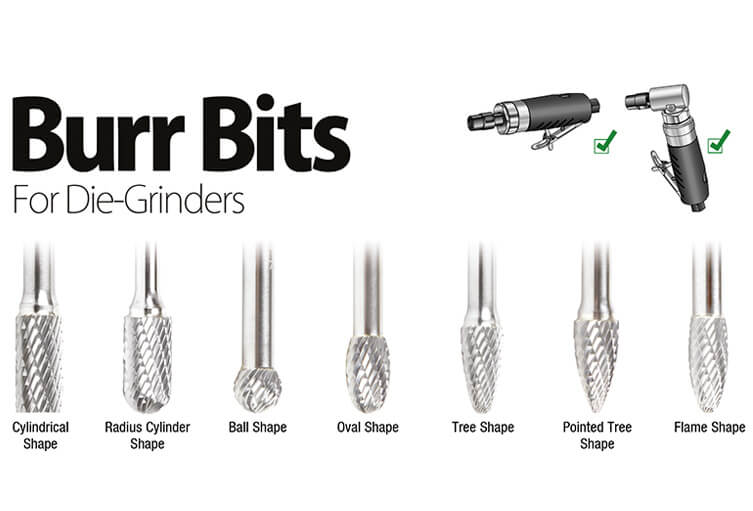Yes, you can use die grinder bits in a drill. But, it’s not always ideal.
Die grinder bits and drills are common tools in many workshops. They each have their specific uses. Die grinder bits are designed for high-speed rotary tools. Drills, on the other hand, operate at lower speeds. When combined, they can sometimes work together for certain tasks.
But it’s important to know the limitations and the best practices. Understanding these can help you make the right choice for your project. So, let’s dive deeper into this topic and explore the compatibility and considerations of using die grinder bits in a drill.

Credit: toolstoday.com
Article Summary
- Introduction To Die Grinder Bits
- Understanding Drills And Their Capabilities
- Compatibility Of Die Grinder Bits With Drills
- Safety Considerations
- Choosing The Right Die Grinder Bit
- Proper Technique For Using Die Grinder Bits In A Drill
- Maintenance And Care
- Expert Tips And Best Practices
- Frequently Asked Questions
- Conclusion
Introduction To Die Grinder Bits
Die grinder bits are versatile tools used for detailed grinding, polishing, and shaping various materials. Understanding their uses can help determine if they can be utilized with a drill. This introduction to die grinder bits will cover what they are and their common applications.
What Are Die Grinder Bits?
Die grinder bits are attachments designed for high-speed rotary tools. They come in various shapes and sizes. Made from durable materials, they can withstand intense use. These bits are often used for precision work. They fit into die grinders, which spin at high speeds.
Common Uses
Die grinder bits are used for many tasks. They can remove rust and paint. They shape wood, metal, and plastic. They are perfect for detailed carving and engraving. These bits can polish surfaces to a smooth finish. They are used in automotive, woodworking, and metalworking projects.
Understanding Drills And Their Capabilities
Die grinder bits can fit into drills, but they may not work well. Drills and die grinders have different speeds and purposes. Using the wrong tool may damage both the bit and the drill.
Drills are versatile tools used in many applications. They can drill holes, drive screws, and even sand surfaces. But what about using die grinder bits in a drill? To understand this, let’s explore the types of drills and their capabilities.Types Of Drills
There are several types of drills, each with unique features. The most common are the corded and cordless drills. Corded drills need a power outlet. They usually have more power and can run indefinitely. Cordless drills are battery-powered. They offer portability and are great for on-the-go tasks. Another type is the hammer drill. It combines drilling and hammering actions. This makes it perfect for masonry work.When To Use A Drill
Drills are used for various tasks. They are ideal for creating holes in wood, metal, and plastic. Use them to drive screws into different materials. They also work well for mixing paint or mortar with special attachments. Drills can even sand surfaces with the right accessories. But using die grinder bits in a drill? It’s not recommended. Drills and die grinders have different speed ranges. Die grinder bits need high speeds, which drills cannot provide. This mismatch can damage both the drill and the bit. “`Compatibility Of Die Grinder Bits With Drills
Die grinder bits can be used in a drill with the right adapter. They are useful for detailed work. Ensure the drill’s speed matches the bit’s requirement.
Using die grinder bits in a drill can be tempting. Many DIY enthusiasts consider this option. It seems convenient and cost-effective. But is it compatible? Let’s explore this topic in detail.Potential Issues
First, consider the speed difference. Die grinders rotate at high speeds. Drills usually operate at lower RPMs. This mismatch can cause problems. Second, check the shank size. Die grinder bits have smaller shanks. Drills have larger chucks. This difference can lead to fit issues. Third, think about the torque. Drills generate more torque. Die grinder bits are not designed for this. Excess torque can damage the bits.Benefits And Drawbacks
One benefit is versatility. Using existing drill and bits saves money. No need for extra tools. It’s a simple, cost-effective solution. On the downside, performance may suffer. Die grinder bits work best at high speeds. Drills can’t match this speed. The result? Inefficient and slow work. Another drawback is safety. Using mismatched tools can be dangerous. Bits may break. Injuries can occur. In summary, consider these factors. Compatibility depends on speed, shank size, and torque. Benefits include cost savings. Drawbacks include performance and safety concerns. “`
Credit: www.reddit.com
Safety Considerations
Using die grinder bits in a drill can be convenient, but safety is crucial. Always prioritize safety to prevent accidents and injuries.
Protective Gear
Always wear protective gear when using a drill with die grinder bits. This includes:
- Safety glasses to protect your eyes from flying debris.
- Ear protection to shield your ears from loud noises.
- Gloves to protect your hands from sharp edges and heat.
- Dust mask to avoid inhaling harmful particles.
Wearing the right gear can save you from serious injuries.
Safe Operation Techniques
Follow these safe operation techniques to ensure a smooth and safe experience:
- Secure the drill bit firmly to avoid slipping.
- Use both hands to control the drill.
- Operate the drill at a low speed to maintain control.
- Keep the work area clean and free of obstructions.
- Regularly inspect the drill and bits for wear and tear.
These techniques can help you maintain control and prevent mishaps.
Choosing The Right Die Grinder Bit
Choosing the right die grinder bit is crucial for achieving the best results. The type of bit you use can make a big difference in your work’s quality and efficiency. Let’s explore the different factors to consider when selecting die grinder bits.
Material Types
Die grinder bits come in various materials. The most common are carbide, high-speed steel, and diamond-coated bits. Carbide bits are durable and handle tough materials well. High-speed steel bits are less expensive and work for general purposes. Diamond-coated bits are perfect for cutting and grinding hard materials.
Bit Shapes And Sizes
Die grinder bits also come in many shapes and sizes. Each shape serves a different purpose. For instance, cylindrical bits are great for flat surfaces. Ball-shaped bits work well for rounding edges or making concave cuts. Cone-shaped bits are ideal for precise detail work and angled cuts. Always choose the bit shape based on your project’s needs.
Sizes of die grinder bits vary too. Smaller bits offer more precision and are useful for detailed tasks. Larger bits remove material quickly but can be less precise. Match the bit size to your specific task for the best results.
Proper Technique For Using Die Grinder Bits In A Drill
Using die grinder bits in a drill requires caution. Secure the bit firmly and apply light pressure. Always wear safety goggles.
Using die grinder bits in a drill can be handy. It allows for more versatility. But, it’s crucial to follow the proper technique. This ensures safety and the best results. Let’s dive into the steps for using die grinder bits in a drill.Securing The Bit
First, choose the right bit for your task. Ensure it’s compatible with your drill. Insert the bit into the drill’s chuck. Tighten the chuck securely. This prevents the bit from slipping. Check the bit’s alignment. It should be straight and firm.Maintaining Control
Start the drill at a low speed. High speeds can cause the bit to wobble. Hold the drill firmly with both hands. Apply steady pressure. Do not force the bit into the material. Let the bit do the work. Keep a consistent speed for smooth results. Always wear safety goggles. This protects your eyes from debris. “`Maintenance And Care
Proper maintenance and care of your die grinder bits will extend their life and ensure they perform well. This section will provide essential tips on cleaning and storing your die grinder bits.
Cleaning The Bits
Keeping your die grinder bits clean is crucial for their efficiency. After each use, make sure to remove any debris or residue. Follow these simple steps:
- Remove the bit from the drill or grinder.
- Brush off any loose debris with a wire brush.
- Soak the bit in a mild solvent for a few minutes to loosen tough residue.
- Scrub gently with a soft brush to avoid damaging the cutting edges.
- Rinse thoroughly with clean water and dry the bit completely.
Storing The Bits
Proper storage prevents damage and keeps your bits in good condition. Follow these guidelines:
- Store in a case: Use a dedicated case to keep bits organized and protected.
- Avoid moisture: Store bits in a dry place to prevent rust.
- Separate by type: Keep different types of bits separated to avoid them rubbing against each other.
- Label the case: This helps you find the right bit quickly.
By following these maintenance and care tips, you’ll ensure your die grinder bits remain in top condition for a long time.

Credit: www.youtube.com
Expert Tips And Best Practices
Using die grinder bits in a drill can be a game changer for some tasks. But, it requires careful handling and knowledge. Here, we provide expert tips and best practices to help you use die grinder bits in a drill effectively and safely. This section includes advice from professionals and common mistakes to avoid.
Advice From Professionals
- Choose the Right Bit: Not all die grinder bits are compatible with drills. Ensure the bit’s shank fits the drill chuck.
- Speed Control: Die grinders operate at higher speeds. Use a variable speed drill for better control.
- Use Proper PPE: Always wear gloves, safety glasses, and ear protection.
- Lubrication: Apply lubricant to reduce heat and friction. This extends the bit’s life.
- Steady Hands: Maintain a firm grip. This prevents the bit from slipping.
Common Mistakes To Avoid
- Overheating: Running the drill at high speeds can cause overheating. Use lower speeds and take breaks.
- Improper Fit: Using bits that don’t fit the drill chuck can be dangerous.
- Lack of PPE: Skipping personal protective equipment increases the risk of injury.
- Excessive Pressure: Applying too much pressure can damage both the bit and the drill.
- Skipping Lubrication: Not using lubricant can cause the bit to wear out faster.
Following these tips and avoiding common mistakes can help you use die grinder bits in a drill safely and effectively. Always prioritize safety and ensure the tools are compatible and properly maintained.
Frequently Asked Questions
Can You Use Die Grinder Bits In A Drill?
Yes, you can use die grinder bits in a drill. However, ensure the drill’s speed matches the bit’s requirements for safety and efficiency.
What Is The Difference Between A Die Grinder And A Drill?
A die grinder is designed for precision work with high-speed rotation. A drill is used for drilling holes and has lower rotational speeds.
Are Die Grinder Bits Universal?
Die grinder bits are not universal. They come in various sizes and shank diameters, so ensure compatibility with your drill.
Can Die Grinder Bits Damage A Drill?
Using die grinder bits incorrectly can damage a drill. Ensure proper speed settings and compatibility to avoid damage.
Conclusion
Using die grinder bits in a drill is possible with care. Ensure the bit fits securely. Check the speed compatibility. Be mindful of safety precautions. Proper usage prevents damage and ensures safety. Always wear protective gear. Make sure your tools are suitable.
Choosing the right tool enhances efficiency. Remember, not all bits are interchangeable. Stay informed and work safely. Your projects will benefit from the right tools. Happy crafting!